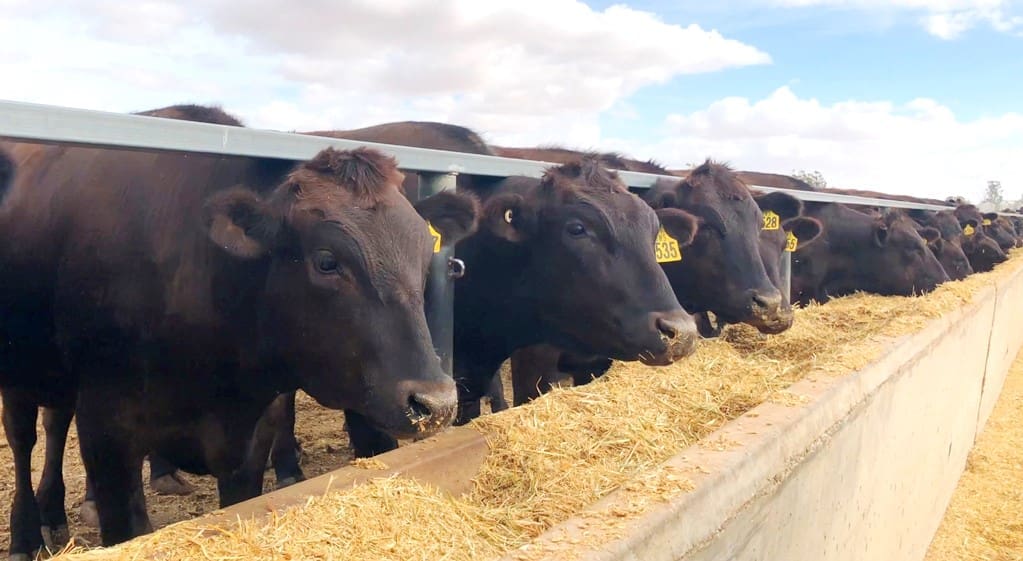A WORLD-FIRST trial using the methane-inhibiting seaweed asparagopsis in Wagyu feedlot rations has delivered promising results and further demonstrated the potential of feed additives to help cattle producers reduce enteric methane emissions.
However the methane inhibition effect – in this trial at least – was nothing like reduction claims of anywhere between 70pc and 90pc made in earlier laboratory trials.
Conducted over 275 days on 80 head of Wagyu F1 cattle fed typical Japanese-style grower and finisher rations under commercial feedlot conditions, the AA Co trial resulted in 28 percent enteric methane abatement, with no impact on safety, flavour, product integrity or marbling score.
Due to a decline in liveweight, methane intensity (g/kg LW gain) did not differ between treatments.

AA Co chief executive Dave Harris
Australian Agricultural Co managing director and chief executive David Harris said the trial broke new ground as the longest of its kind and demonstrated AA Co’s commitment to sustainability.
“This trial was an important step forward and we’re encouraged by the results,” Mr Harris said.
“Based on previous trials that were primarily with cattle fed for 100 days, we anticipated a higher methane abatement, however reducing emissions by almost 30pc is still significant,” he said.
“Considering the nature of the trial, we will look at the positives and take away the learning opportunities. It helped us understand more about how to apply asparagopsis and what we can consider to improve outcomes in the future.
“There is no silver bullet to eliminating enteric methane emissions, but we’ll keep trying and we’ll discover how to make it work in our environment. The important thing is that we are determined to get there.”
Mr Harris said there were other important outcomes such as the flavour and marbling results and the sustained use of asparagopsis oil without the rumen adapting that made the trial a success. Consistent with other research, there was no bromoform detectible in meat or offal samples.
“No one had tested those things in Wagyu previously, but they are important findings especially as a beef company selling a premium product into global markets,” he said.
“Importantly, we also learned that it’s safe for long-fed cattle like Wagyu to consume over those extended periods.”
In addition to the lower methane abatement, the trial raised several questions including a reduction in liveweight gain of 9.38pc as well as the type and volume of ration required to get outcomes in Wagyu cattle.
The treated group produced average daily gain of 0.87kg/day, versus 0.96kg/day for the control group. Lower rate of gain resulted in carcase weights 15.1kg lighter in the group receiving the additive. Hot standard carcase weights were 391kg versus 406kg.
 In discussion in the research report, researchers said inherent aversiveness (taste) and negative post-ingestive feedback mechanisms may explain reduced intake where asparagopsis, especially in a FD state, has been blended into a total mixed ration.
In discussion in the research report, researchers said inherent aversiveness (taste) and negative post-ingestive feedback mechanisms may explain reduced intake where asparagopsis, especially in a FD state, has been blended into a total mixed ration.
“However, reduced intake of basal diet has also been observed where asparagopsis has been offered as a separate supplement. Furthermore, the use of asparagopsis infused in oil in the present experiment removes many potential confounding factors associated with feeding whole seaweed biomass, as the oil consists only of the lipid-soluble compounds from the seaweed, including CHBr3, iodide and bromide. Some intake suppression has also been demonstrated when beef cattle CH4 production is suppressed by other ameliorants, such as 3-NOP, either initially, or when very high inclusion rates are used, although this is not sustained in the long term.”
“Together, this may support hypotheses that reduced feed intake is a result of methane suppression in general, rather than specific characteristics of asparagopsis, or the asparagopsis compound carried in oil.”
More funding needed for research
AA Co’s David Harris said the trial demonstrated that there was “still a lot we don’t know about such feed additives, but that’s not a bad thing.”
“Without testing the science, we won’t know how to solve the methane challenge,” he said.
“There is significant potential with methane abatement technology. While it’s not perfect yet, with more funding for research and better collaboration with government we can get there.
“We want to be part of the climate change solution. The question is, how do we make this work for everybody? This trial was another important piece in that puzzle.”
Mr Harris said AA Co would now advance other trial work in methane abatement, including potential opportunities with asparagopsis.
“We will need diversity in solutions to tackle this issue across our supply chain and we still view asparagopsis as a part of that mix,” he said.
“Feedlots are a small component of our emissions profile. The greater challenge will be tackling methane in extensive grazing environments such as our stations, which can be more than a million square kilometres in size.
“So, we will look at multiple pathways and a range of interventions. Feed additives generally are only one part of the solution. There will be other approaches and technologies that emerge to complement them.
“We look forward to making further announcements about this work in the near future.”
The trial was conducted in collaboration with Meat & Livestock Australia, Sea Forest, University of New England and University of Queensland.
- See MLA’s perspective about the trial in a separate article today.



What benefit has been demonstrated in this work?
1) The CH4 / kg carcass is not different with or without seaweed. So for the same beef production at scale, there is no CH4 reduction.
2) Including a tiny daily amount reduced intake enough to strip 15kg of carcass over the feeding period, a more than 10% reduction in daily liveweight gain. So to maintain a greater carcass weight, longer times on feed, with greater maintenance costs, would be needed. At that point, CH4 output is actually increased.
3) On an industry level, these dual costs – supplement price and production losses – are simply unaffordable.
4) What energy was required to harvest seaweed, dry it, grind it or extract the oil? Was it done by diesel boats and coal fired electricity?
5) Bromoforms are still classed as potential carcinogens in the EU – how thoroughly was offal/carcass tissue tested ? What level of bromoforms in the food chain deliberately added is OK for consumers to wink at?
The maths isn’t looking good with this trial.
It seems this result isn’t promising. Jim raised very important issues. So as a result of this study asparagopsis isn’t reducing the enteric CH4, while it’s economical losses. Because we need to see emissions intensity (g CH4/kg beef) than CH4 production (g/day), to say this additive is either CH4 abatement or not.